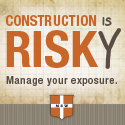
| www.agc.org • March 2017 |
Contact Us Archives
Subscribe Printer-Friendly AdvertiseSafety and HealthFacebook |
Executing High-Quality Safety Audits on the Construction Site BY JERRY FLEMMING, VICE PRESIDENT, JAMES MCHUGH CONSTRUCTION CO.
A Builders Association member The standardized safety audit, while itself does not constitute a comprehensive risk management strategy, is a critical part of assessing and measuring safety on the construction site.
If done properly, the auditing process can become one of a company’s greatest training tools, setting the stage for team members to realize their roles in managing risk. If done poorly, however, contractors run the risk of promoting an organizational culture where risk is only assessed during the formal auditing process or – worst case scenario – negative findings are ignored.
A streamlined, consistent approach to auditing safety is every contractor’s mandate. It requires a thoughtful approach where the expectations are clearly defined, the training comprehensive and the execution flawless. The following recommendations will help contractors better execute safety audits and make risk management not just a priority, but an expectation.
Recommendation #1: Setting the Stage
Defining expectations related to safety audits can be done only after the value placed on risk management has been established and communicated.
First and foremost, leadership must redefine risk management by conveying to all employees – from crew members to estimators to accountants – that everyone is a safety manager and, as such, is responsible for assessing and managing risk within their departments. On the worksite, this means discussing potential hazards and creative solutions with all team members, not just the designated safety managers.
Perhaps the most important thing company executives can do to set the stage for a high-quality safety auditing process is to eliminate bureaucracy from auditing. Traditional safety audits beget bureaucracy; it can be tempting to record safety hazards and await review and direction from leadership. Instead, empower employees during the auditing process to stop and correct issues as they arise. In short, take an "act now, report later" approach.
As with any systematic approach to safety, participation from leadership is a must. Require that members of the leadership team – from upper management to field supervisory personnel (and everyone in between) – conduct frequent safety audits. Whenever possible, those audits should be done with a lower ranking individual with the goal of further teaching and developing future leaders.
While it’s vital to put safety assessment in the hands of everyone on the construction site, it’s equally important to strategically engage safety managers. Scheduling frequent project tours with the full safety leadership team achieves two important objectives: first, it offers safety managers an opportunity to share best practices with one another, which may influence safety outcomes on other projects; second, it offers project teams a fresh set of eyes through which to identify and assess risk on the worksite.
Recommendation #2: Training Employees to Recognize and Assess Risk
Proper training can be the difference between a high-quality safety audit and a poor one (and the difference between a win and a loss on the construction site).
The single greatest way managers can impact the execution of high quality safety audits is to assume nothing when it comes to training. Assuming that new personnel know how to recognize risk is a mistake; instead, show them how to see, feel, hear and smell basic hazards by employing all their senses. Assign mentors who will walk the sites with new personnel and challenge their assumptions about what constitutes risk. As their competencies increase, mentors should shift their efforts to focus to how employees can correct – rather than just spot – more complex or less recognizable safety hazards on the construction site.
Throughout training, demand that your crew members take risk and safety assessment beyond the formal audit. Reserving the act of assessing safety and risk management for formal inspections conveys to employees that safety auditing isn’t a priority outside of the inspection window. This can quickly become a hazard in and of itself. Instead, train employees to constantly be evaluating their worksites by instituting a system that requires employees to spot and correct issues every day.
Next, and much aligned with the concept that everyone is a safety manager, leadership should train employees on the "see it, own it" approach to safety auditing. If a team member – any team member – spots a safety concern, the expectation should be that the crew member stops what he or she is doing and either resolves the concern or manages the situation until a resolution has been determined. Never should a team member leave a safety hazard until a remedy is in progress and the site of the hazard is deemed safe.
Finally, remember that training should not end with the formal onboarding process. In fact, some of the most important training opportunities come throughout the employment experience when leadership corrects and adjusts behavior on-the-spot. As roles and responsibilities broaden, saving critical feedback for annual performance evaluations is no longer effective. Rather, managers should address safety concerns as they arise, offering on-the-spot constructive criticism to further increase competencies and to build trust among their teams.
Recommendation #3: Executing Quality Safety Audits
Once the stage is set and employees have been properly trained, high quality safety audits can be executed.
As with many aspects of our industry, leveraging technology can help streamline the auditing process while eliminating some of the inefficiencies inherent in the more traditional approach. Electronic audits have myriad benefits; they are more time-efficient, as they eliminate aspects of the audit that may not pertain to a certain project; they may help reduce instances of error due to spelling or language barriers; and users of electronic audits are able to capture more detailed analyses of safety concerns through imagery.
Further, as companies aim to take auditing beyond the formal process, employing video conference systems such as FaceTime or Skype provide on-site employees the ability to access managers and other resources when in need of assistance.
Next, the benefits of implementing a process of repeat audits cannot be understated. Formal audits conducted back-to-back by different individuals ensure a fresh set of eyes is focused on mitigating risk on the worksite each day. The repeat audit also serves as a training tool in the event any concerning safety conditions remain or require additional follow-up by the project team or safety leads.
Company leadership can promote a culture that strives for flawless execution of safety audits by making audits available for internal review. The old school of thought – the "don’t air your dirty laundry" approach – lead to a propensity for safety managers to keep negative audits under wraps, which benefits no one. Posting audits for employees across the organization to review is not only an accountability tool, but a learning tool as well. The safety nuances of one worksite have the potential to impact that way crew members view hazards at other sites.
Last but not least, you are not doing your team or your company any favors if you are only auditing for hazards or concerns. Instead, always strive to audit for the positive, too. It’s critical to recognize and applaud good safety practices – even the most minor good habits and behaviors – so crew members continue to employ them. Then, when things are going well, say thanks, shake hands and celebrate the wins. Showing appreciation to your personnel will reinforce your commitment to risk management.
The process of auditing safety practices can be one of the most important tools to mitigate risk on the construction site. It is the responsibility of executive leadership and on-site management to create and maintain an environment that encourages field personnel to be honest and forthcoming in their audits, both formal and informal.
Contractors should strive to celebrate the findings – good, bad and ugly – because recognizing risk is the only way to eliminate it. Jerry Flemming is the vice president of risk management for James McHugh Construction Co. in Chicago, a Builders Association member. Flemming has more than 25 years’ experience in safety and risk management. He previously served as a vice president for Clayco, Inc. before founding Risk Avoidance Consultants where he consulted with construction companies and general contractors on how to mitigate and manage risk. Since joining McHugh in 2011, Flemming has guided the company to achieve its lowest Experience Modification Rate – a 0.46 – while overseeing some of McHugh’s most complex and expansive projects to date. He continually challenges safety assumptions and is always looking for ways to improve and advance the risk management function.
|
|||
 2300 Wilson Boulevard, Suite 300 · Arlington, VA 22201 · 703-548-3118 (phone) · 703-548-3119 (fax) · www.agc.org
2300 Wilson Boulevard, Suite 300 · Arlington, VA 22201 · 703-548-3118 (phone) · 703-548-3119 (fax) · www.agc.org
About AGC | Advocacy | Industry Topics | Programs and Events | Career Development | News & Media
© Copyright 2024 The Associated General Contractors of America. All rights reserved.

